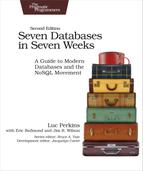Wrap-Up
The Redis key-value (or data structure) store is light and compact, with a variety of uses. It’s akin to one of those multitools composed of a knife, can opener, and other bits and bobs like a corkscrew—Redis is good to have around for solving a variety of odd tasks. Above all, Redis is fast, simple, and as durable as you choose. While rarely a standalone database, Redis is a perfect complement to any polyglot ecosystem as an ever-present helper for transforming data, caching requests, or managing messages by way of its blocking commands.
Redis’s Strengths
The obvious strength of Redis is speed, like so many key-value stores of its ilk. But more than most key-value stores, Redis provides the ability to store complex values such as lists, hashes, and sets, and retrieve them based on operations specific to those datatypes. Beyond even a data structure store, however, Redis’s durability options allow you to trade speed for data safety up to a fairly fine point. Built-in master-slave replication is another nice way of ensuring better durability without requiring the slowness of syncing an append-only file to disk on every operation. Additionally, replication is great for very high-read systems.
Redis’s Weaknesses
Redis is fast largely because it resides in memory. Some may consider this cheating because, of course, a database that never hits the disk will be fast. A main memory database has an inherent durability problem; namely, if you shut down the database before a snapshot occurs, you can lose data. Even if you set the append-only file to disk sync on every operation, you run a risk with playing back expiry values because time-based events can never be counted on to replay in exactly the same manner—though, in fairness, this case is more hypothetical than practical.
Redis also does not support datasets larger than your available RAM (Redis is removing virtual memory support), so its size has a practical limitation. Although there is a Redis Cluster currently in development to grow beyond a single machine’s RAM requirements, anyone wanting to cluster Redis must currently roll their own with a client that supports it (like the Ruby driver we used in Day 2).
Parting Thoughts
Redis is chock-full of commands—more than 120 of them. Most commands are straightforward enough to understand by their names alone, once you get used to the idea that seemingly random letters will be removed (for example, INCRBY) or that mathematical precision can sometimes be more confusing than helpful (for example, ZCOUNT, or sorted set count, vs. SCARD, or set cardinality).
Redis is already becoming an integral part of many systems. Several open source projects rely on Redis, from Resque, a Ruby-based asynchronous job queueing service, to session management in the Node.js project SocketStream. Regardless of the database you choose as your SOR, you should certainly add Redis to the mix.
